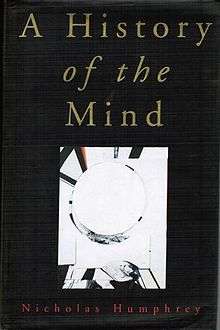A History of the Mind
 Cover of the first edition | |
| Author | Nicholas Humphrey |
|---|---|
| Country | United Kingdom |
| Language | English |
| Subject | Mind–body problem |
| Published | 1992 (Chatto & Windus) |
| Media type | Print (Hardcover and Paperback) |
| Pages | 230 |
| ISBN | 978-0387987194 |
A History of the Mind is a 1992 book about the mind–body problem by Nicholas Humphrey. It has been called one of the most interesting attempts to solve the problem.
Summary
Humphrey attempts to solve the mind-body problem, and responds to philosopher Colin McGinn's argument that the problem cannot be solved.[1] Humphrey holds that consciousness is immediate sensory experience and that sensation-arousing stimuli define who we are, how we feel, and what we know. This is a view that differs from that of Daniel Dennett in his Consciousness Explained (1991).[2]
Reception
Author Richard Webster, writing in his Why Freud Was Wrong (1995), called A History of the Mind one of the most interesting attempts to solve the mind/body problem. In Webster's view, while Humphrey presents his work as an attempt to fully solve the mind-body problem, he actually uses the theory of natural selection to try to show that the problem of consciousness can be solved not through the philosophy of mind but though evolutionary biology. A History of the Mind thus sees the problem of "mind" as an illusion produced by the failure to understand evolutionary history and neurophysiology. Webster suggests that Humphrey thereby succeeds in eliminating mind-body dualism entirely, although he notes that some details of Humphrey's hypothesis remain highly speculative and open to criticism, and that it was rejected by McGinn.[1]
See also
References
Footnotes
- 1 2 Webster 2005. p. 484.
- ↑ Johanson 1996. p. 107.
Bibliography
- Books